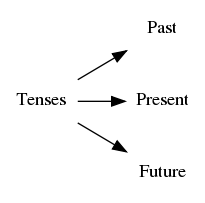How to use english tenses
Tense changes are always meaningful, and they always signal a change in the function of the information — so don’t change tense randomly and make sure you remember to change tense when you should.
Another way to figure out what the writer is doing in a sentence is to look at the grammar and vocabulary clues. What is the tense of the main verb? What is that tense normally used for? Is it the same tense as in the previous sentence? If not, why has the writer changed the tense? What words has the writer chosen to use?
Table of tenses
| Past | Present
The present tenses describe the current moment, past events with a relationship to the current moment, and timeless facts. These tenses bridge the gap between the past and present, and can also be used (with future times) to show what will happen later. This makes them more flexible than the past tenses, and more complicated. They can show: Something happens generally. Something is happening now. Something has happened recently. Something has been happening before now, for some time. These tenses give you the ability to explain the present moment, timeless rules, and the past and future in relation to now. |
Future | |
|---|---|---|---|
| Simple
There are many common state verbs that use the simple tenses; they can be grouped to demonstrate states of mind (suppose, think, believe, understand, know, want, love, hate, need, like, prefer), existence or possession (be, have, exist, belong, own) and senses (feel, smell, seem, taste, appear, look). Learn these examples, and be careful to use the simple tenses for them, and it will become clear when similar verbs are appropriate. |
Past Simple | Present Simple | Future Simple |
| Perfect | Past Perfect | Present Perfect
For example, the present perfect is usually used to discuss visited locations, because experiences in different locations continue to affect us now, and can be added to, such as “I have been to France.” |
Future Perfect |
| Continuous | Past Continuous
The past continuous tells us that the action started but had not finished (it was ongoing) at a specific point in the past. |
Present Continuous | Future Continuous |
| Perfect Continuous | Past Perfect Continuous | Future Perfect Continuous | Future Perfect Continuous |
Graph of tenses

The past simple and the past continuous should not be confused. If you need to choose between the two, remember the past simple shows a completed action but the past continuous shows the action was in progress (it had started).
Another area that can cause confusion is when using states. For verbs showing states, for existence, possession and senses (such as be, have, seem, look, sound), the Past Simple is used, even for temporary or ongoing actions. I was happy before the phone rang. (not I was being happy) He seemed angry when we saw him at 4pm.
Past Simple / Present Perfect
- Past Simple I broke my glasses… but it doesn’t matter/I repaired them.
- Present Perfect / I have broken my glasses… and so I can’t see properly NOW.
For example, the Present Perfect is usually used to discuss visited locations, because experiences in different locations continue to affect us now, and can be added to, such as “I have been to France.”
